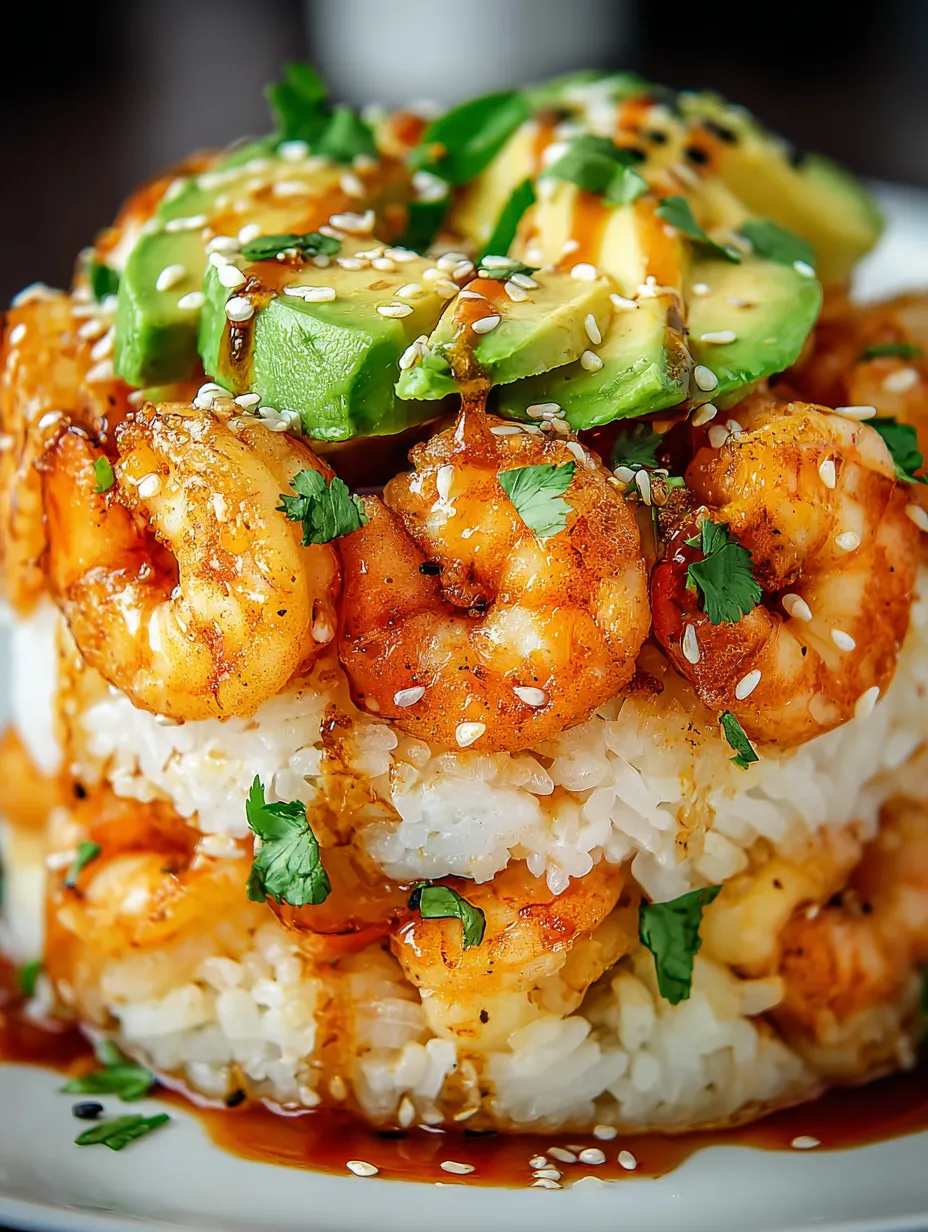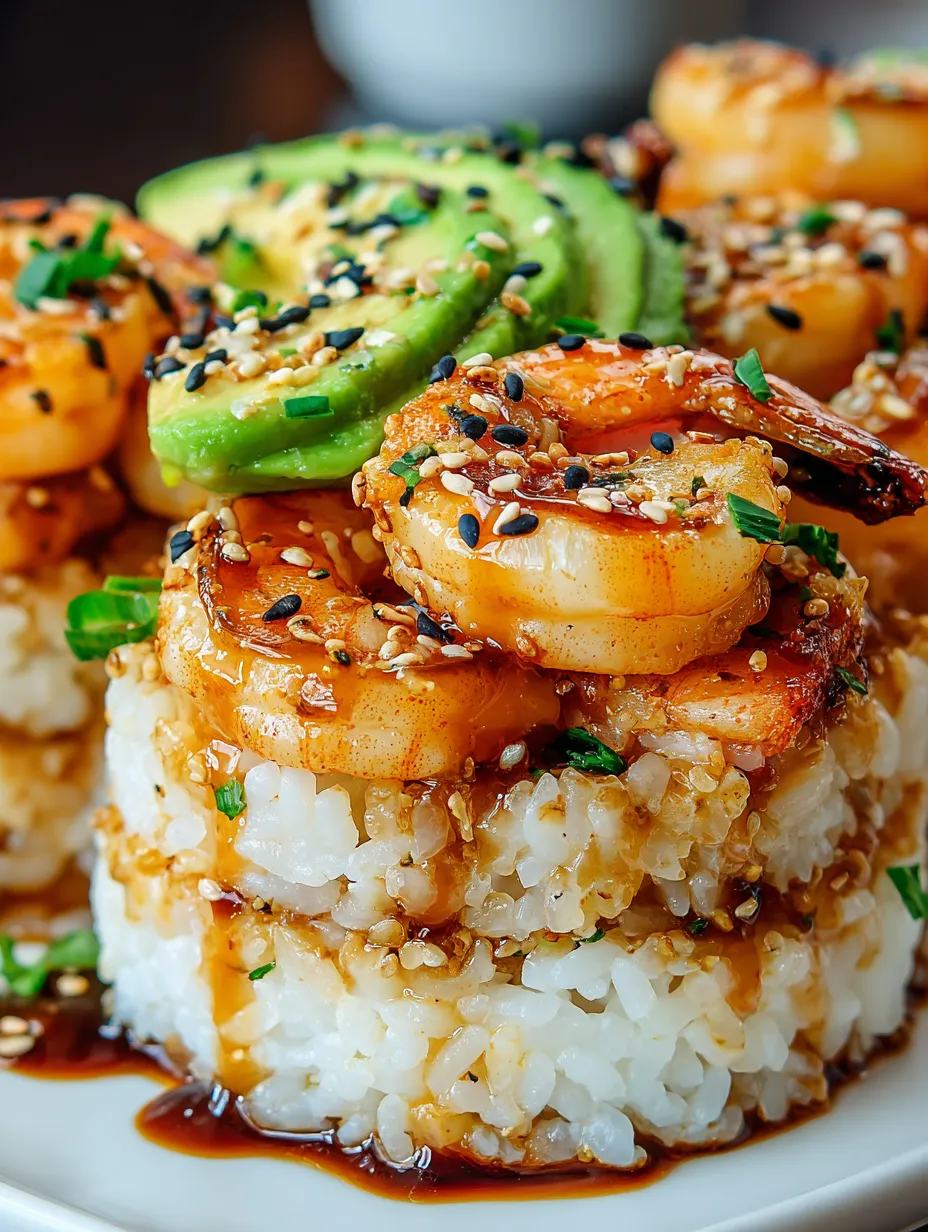 Pin
Pin
Spicy Shrimp Sushi Stacks offer all the excitement of a sushi roll with none of the rolling hassle. They showcase tender shrimp tossed in spicy mayo layered over seasoned sushi rice plus crisp cucumber and creamy avocado for the ultimate satisfying and fresh meal. This recipe is my go to when I want to serve something colorful and fun that feels special without taking hours in the kitchen. With each bite you taste the warmth of the shrimp the tang of rice and the cool richness of avocado and veggies. I was instantly hooked after trying these at a tiny sushi spot and now this is a regular treat whenever I want something to impress guests or just treat myself.
The first time I put these stacks together at a family get together everyone kept going back for more. Now it is my number one request when friends come over and I love reinventing it with what is in the fridge.
Ingredients
- Large shrimp peeled and deveined: look for wild or sustainably sourced shrimp for the best taste and texture
- Olive oil: adds rich flavor and helps sear the shrimp
- Soy sauce: choose low sodium if you like to control saltiness
- Rice vinegar: balances flavors and is key for classic sushi rice seasoning
- Sugar: a touch brings out the natural sweetness of shrimp and rice
- Sesame oil: gives depth and nutty aroma select toasted sesame oil if possible
- Sriracha sauce: provides heat you can adjust based on your preference
- Mayonnaise: creates creamy spicy sauce Japanese mayo if available is extra rich
- Sushi rice: short grain rice is best for that traditional sticky texture
- Water: for cooking the rice use filtered for pure flavor
- Salt: brings all the ingredients together use sea salt for clean finish
- Avocado sliced: pick avocados that yield to gentle pressure but are not mushy
- Cucumber julienned: extra crisp and refreshing Persian or English cucumbers tend to be most tender
- Sesame seeds: optional for garnish toasted adds crunch
- Fresh cilantro or green onions: optional for garnish and color boost
Step-by-Step Instructions
- Cook the Sushi Rice
- Rinse the Rice
Pour your sushi rice into a fine mesh strainer and rinse under cold water several times until the water turns clear. This washes away extra starch and ensures each grain cooks up fluffy rather than gummy.
Cook the Rice
Combine rinsed rice and measured water in a medium pot. Bring it to a boil then lower the heat and cover tightly. Simmer for about fifteen minutes until water is absorbed and rice is tender. If possible let the rice rest covered for five to ten minutes off the heat so it finishes steaming.
Season the Rice
While the rice is still hot gently stir in rice vinegar and salt using a paddle or wide spatula to avoid crushing the grains. Cover and let the rice cool briefly so it soaks up the seasoning. - Prepare the Shrimp
- Cook the Shrimp
Pat shrimp dry with a paper towel so they sear well. Heat olive oil in a large skillet over medium high and add shrimp in a single layer. Cook two to three minutes per side without moving much so a golden crust forms and they turn opaque.
Season the Shrimp
Whisk soy sauce rice vinegar sesame oil sugar and sriracha together. Pour this over the cooked shrimp and toss for another minute as the sauce thickens and coats every piece. Transfer to a plate to cool slightly. - Assemble the Sushi Stacks
- Layer the Rice
Scoop about a quarter cup of sushi rice into the base of a round mold or bowl. Gently press to compact it evenly so your stack holds together.
Add Shrimp
Spoon a generous layer of the spicy shrimp mixture over the rice pressing lightly so the shrimp nestle in.
Add Avocado and Cucumber
Top with sliced avocado fanning for coverage. Layer julienned cucumber for extra crunch and color.
Garnish
Right before serving sprinkle on sesame seeds and add chopped cilantro or sliced green onions for brightness.
 Pin
Pin
My favorite thing about this recipe is how sesame oil transforms the sauce and ties everything together. It reminds me of making homemade sushi with my sister growing up when we would always sneak a drizzle of sesame oil into the rice.
Storage Tips
Store shrimp and rice separately in airtight containers if prepping ahead. Both keep well in the fridge for up to two days. Assemble stacks just before serving so textures stay fresh and vibrant. Leftover rice can be microwaved with a splash of water to restore softness. I would avoid freezing the full stacks but leftover cooked shrimp can be frozen for up to one month.
Ingredient Substitutions
Use sushi grade or cooked crab chopped fine instead of shrimp for a sweet twist. Try mashed chickpeas or seasoned tofu for a vegetarian version. For a soy free recipe swap in coconut aminos or gluten free tamari and you can use dairy free mayo if needed.
Serving Suggestions
Set out an array of garnishes like extra sriracha thin sliced radish or nori strips so everyone can build their perfect stack. This dish also works well served family style in a big bowl for easy sharing at parties. I love adding pickled ginger and a little soy sauce on the side for the full sushi bar vibe.
 Pin
Pin
Cultural and Historical Context
Sushi stacks are a modern play on Japanese sushi that trade in delicate rolling for easy layering but still honor the core elements of sushi rice fresh seafood and flavorful toppings. This dish captures the spirit of fusion cuisine blending Japanese technique with global flavors for something unique and approachable at home.
Frequently Asked Questions About the Recipe
- → Can I use frozen shrimp?
Yes, thaw the shrimp fully and pat dry before cooking for best texture and flavor.
- → What type of rice works best?
Sushi rice is preferred for its sticky texture, but short-grain rice can be substituted if needed.
- → How do I make the dish less spicy?
Reduce the sriracha in the sauce or use a milder chili paste for a gentler heat.
- → Can I prepare components ahead of time?
Yes, both the shrimp and sushi rice can be made in advance and kept refrigerated until assembly.
- → Are there alternative toppings?
Try adding mango, crispy nori, or extra vegetables like julienned carrots or pickled ginger for variety.
- → Is the dish gluten-free?
Use gluten-free soy sauce or coconut aminos to keep the dish gluten-free.
